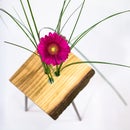Introduction: Glowing Crepe Paper Rose
Crepe paper rose is something you can get away pretty well as a birthday gift or addition to it for a lady - usually well received, isn't too difficult to make and never wilts. I've made some last year and this year there was an occasion for another person so I thought why not!
There's just this thing that I don't like making the same thing over and over again and some surprise factor should remain in an item. It just so happens that adding a source of light makes most of the stuff better so I figured this shouldn't be an exception to the rule. That's how the glowing crepe paper rose was born.
Forgive me the very average pictures - I was making most of this on the same day before birthday party I was attending, which I of course was still late for due to things not going as fast as intended. I do not know where did I get all of this naiveness from to even attempt making something new on the last day.
Step 1: Tools and Materials
Materials:
- Crepe paper of desired colours for the bloom and green for the leaves and other green things
- A garden pole for the stem (in my case Ø16mm and 0.9m long)
- AAA battery holder (preferrably one that fits two batteries on top of each other)
- Some not too thick wires
- Small value resistors (I used 10ohm)
- 2 AAA batteries
- A small 2 position switch
- Some green paint
- A piece of plastic (probably HDPE)
- Thin steel wire (~Ø1-2mm)
- LEDs: I used a single 10mm red one for centre and 6 3528 LEDs on petals. I recommend using either more of 3528 or same number of 5050 though, since more light would really make this look way better
Tools:
- Hot glue gun
- Drill
- Several drill bits including a long one for stem (in my case Ø6mm and around 300mm long)
- Dremel tool
- A router
- Wire strippers
- Solder iron
- X-acto knife
- Scissors
Since this is a list of materials and tools I used, they can of course be substituted for alternatives better or worse.
Step 2: Preparing the Stem
It's wise to start from making the stem, since there'll be some time for cutting petals and stuff while the paint dries. Unless you're in no hurry of course.
The first thing to try and do is definitely drilling a hole in the stem for the wires to go from battery compartment. Despite my best intentions and previous experience of drilling through an axe handle longitudinally this didn't work out nearly as well. The long and relatively thin drill bit flexes therefore reducing the chances of drilling neatly. As I found out - it's no big deal as long as the exit point is low enough to fit battery compartment under the flower bloom.
Fail or no fail while drilling - it's time for making a compartment for the battery holder. If you managed to find a compartment which holds two AAAs longitudinally - just measure that. If not, and you cut a single battery holder like me - the compartment should be a little longer than two AAA batteries (2x44.5mm) to house the holder. With a small cut out for the switch.
I used a router with a 12mm bit for doing most of the work and later did some touch ups with a Dremel and X-acto knife so things fit. The battery holder itself was also cut and sanded with a Dremel.
Other than compartment there's one more thing to cut - the slits for LED wires. These were first done with a oscillating multitool, then widened with a saw because wires didn't fit and then widened once again with a drill bit. Laziness didn't pay off, but at least everything was more or less straight this time.
After all of that is cut it's the time to paint the stem. I didn't apply any primer due to the paint I used having thicker and well covering consistency. After painting I also added several coats of matte clearcoat and it was done. Everything was sprayed on from a can, but brushing would probably be more efficient paint wise.
Step 3: Assembling the Electronics
Due to the shops I visited not having 3528 LEDs I decided to simply unsolder some from a piece of 4.8W/m LED strip I had laying around. Despite unsoldering seems like more work, I believe this actually helped me to do the whole thing faster.
Since I started realizing that I'm not going to make it all in time by now, I thought of a little workflow for creating this LED star before attempting. It was something like this:
- Prepare wires by stripping and tinning them (1st picture)
- Put the wires through each other's hole in the middle and put one side of it into the slits on stem (2nd picture)
- Solder that side, turn around, solder the other side (the dowel is to avoid soldering sides to each other)
- Glue LED strip somewhere
- Unsolder one side of the LEDs and lift it up (3rd picture)
- Solder wires of the soldered star to that side of the LED (4th picture)
- Unsolder the other side
- Solder the other wire to the LED
After this followed a little test on a breadboard with resistors I planned to use and it fortunately worked as intended. I used a single 10ohm resistor before the LED star and then 2 more 10ohm resistors in series before the red LED. It's due to the fact that 2 AAAs in series output 3V white 3528 LEDs operate on 3-3.4V and a red LED on top operates on 1.8 to 2.5V. I should probably have avoided the resistor before the star and had brighter LEDs that way, but it seemed alright while making it.
As for soldering the LED start and the top LED with other wires - solder wires a little longer than the way to reach the battery compartment so you can lift them up a bit and solder together while assembling. Also it's a good idea to add a bit of hot glue on the exposed wires in the middle of the star and have any other wires insulated since there will be some spots where they cross due to the design and it would suck to short something after everything was assembled.
Step 4: Cutting the Petals
Just remember that crepe paper is directional and you'll be fine.
I made the centre red and outside blue because the recipient of this flower likes blue colour. Other than that I believe it is beneficial to seek a thinner and lighter coloured crepe paper for this project due to it letting through and reflecting more light. The red centre is a good example since it's both lighter and thinner than the blue one.
As for cutting - I did it freehand while adhering to approximate dimensions from the template print out available on Martha Stewart webpage. The already doubled sizes are 240x100mm for small petals, 240x210mm for the big ones, 220x100mm for the leaves and 230x120 for the calyx.
Due to the wires going out of stem where the petals need to be glued I simply made some cuts in them seen in 2nd picture. These were done on the blue ones as well.
Step 5: Battery Compartment Lid
I made it from a piece of plastic (most likely HDPE) which I formed using heat from a butane jet torch and other pretty primitive methods as seen in pictures. My geometry was pretty broken so I used a piece almost 2 times too big, but it ended up being a good thing.
In the end the conclusion is that you should roll the plastic around something with a diameter of around 50-65% of the diameter of the object you are making the lid for. I ended up doing it on a 10mm dowel after the drill seen in 2nd picture ended up being too big.
A small hole for switch on top can be made with either a drill or a hole punch.
I chose to wrap the lid in the same green crepe paper as leaves and calyx mainly because it's a flexible part and if painted, the paint would most likely crack. The paper was glued on with hot glue.
Step 6: Putting It All Together
Putting the wiring in can be a little tricky due to the wires remaining for soldering being short, but it's certainly possible. No particular advice here, just be patient and don't forget to put on shrink tubing before soldering. After soldering the switch and wires it may be difficult to get the switch in the spot, but hot glue keeps it there well.
As for the flower itself - there is an excellent video tutorial for making the paper rose on Martha Stewart webpage which you can mostly relate to, but there are some changes due to the need to add wiring somewhere between the petals.
If you made the cuts in petals I mentioned in an earlier step, everything should be fine. Just hot glue the petals, maybe add tape after some more of them are on to add some durability. While gluing the big ones they may be too wide, but you can always make extra cuts like in the 3rd picture so they fit better. While adding petals don't forget to glue LEDs to the petals occasionally. It's a good idea to glue the last LED with around 3 petals left to glue to hide wires or anything else with those last ones. If you like exact numbers: glue a LED to a petal every 2 big petals starting with a 2nd one.
The leaves were glued on a short piece of wire with a hot glue. Stem was drilled diagonally and leaves with wires put in these holes. It's a good idea to drill one of these holes for leaves right under the battery compartment lid, so it has no chance of sliding down the stem if it somehow hops off the switch.
Step 7: Hurry to the Party!
Or enjoy the flower you made if you have time for that.
I'd definitely consider using 5050 LEDs instead of 3528 or using more of the same ones to get the flower to really glow. Thinner and/or lighter crepe paper would help too. Make sure to share your results if you try and make one.
If any questions arise I'll try to answer them all in either comments or via a private message.
Other than Instructables, you can also see the stuff I make and not necessarily make instructions for on Tumblr, Instagram and sometimes Facebook.
Until next time and have a happy New Year!
Raitis

Participated in the
Make it Glow!

Participated in the
Papercraft Contest













